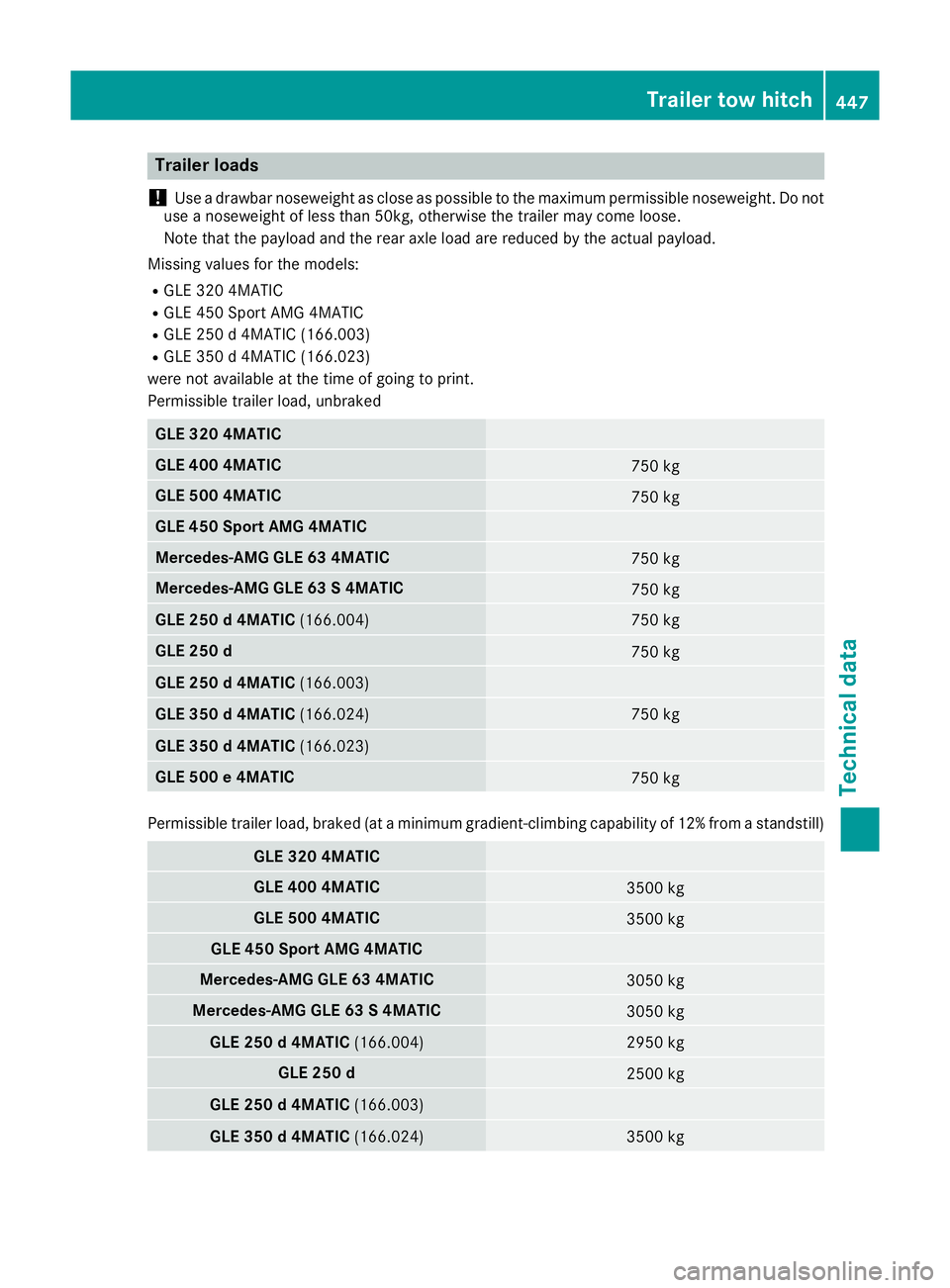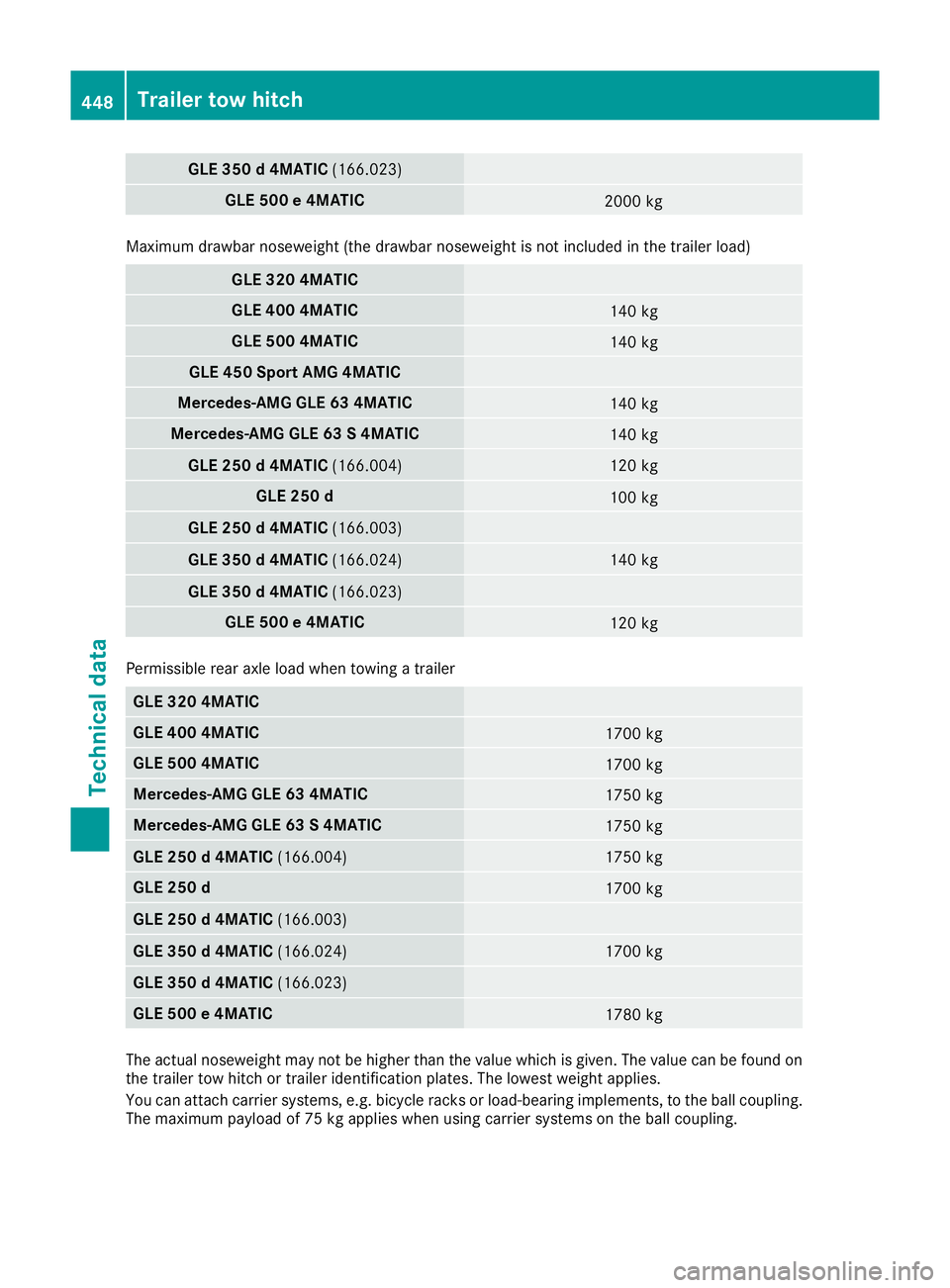Page 420 of 453

!
Always use wheel bolts
;to fit the collaps-
ible emergency spare wheel. Using other
wheel bolts to fit the collapsible emergency
spare wheel could damage the brake system. :
Wheel bolts for all wheels supplied by the
factory and for the collapsible emergency
spare wheel (Mercedes-AMG GLE 63)
; Wheel bolts for the "Minispare" emergency
spare wheel X
Clean the wheel and wheel hub contact sur-
faces.
X Slide the wheel to be mounted onto the cen-
tring pin and push it on.
X Tighten the wheel bolts until they are finger-
tight.
X Unscrew the centring pin.
X Tighten the last wheel bolt until it is finger-
tight.
X Mercedes-AMG vehicles with a collapsi-
ble emergency spare wheel:
inflate the col-
lapsible emergency spare wheel
(Y page 431).
Only then lower the vehicle. Lowering the vehicle G
WARNING
The wheels could work loose if the wheel nuts and bolts are not tightened to the specified
tightening torque. There is a risk of accident.
Have the tightening torque immediately
checked at a qualified specialist workshop
after a wheel is changed.
! Mercedes-AMG vehicles with a collapsi-
ble emergency spare wheel: inflate the col-
lapsible emergency spare wheel using the
tyre inflation compressor before lowering the vehicle. There is otherwise a risk of damaging
the wheel.
X Place the ratchet ring spanner onto the hex-
agon nut of the jack so that the letters ABare
visible.
X Turn the ratchet ring spanner until the vehicle
is once again standing firmly on the ground.
X Place the jack to one side. X
Tighten the wheel bolts evenly in a crosswise
pattern in the sequence indicated (: toA).
The tightening torque must be 150 Nm.
X Turn the jack back to its initial position.
X Stow the jack and the rest of the tyre chang-
ing tools in the stowage well under the boot
floor.
X Check the air pressure of the newly fitted
wheel and adjust accordingly.
Observe the recommended tyre pressure
(Y page 408).
If you are driving with the emergency spare
wheel fitted, the tyre pressure loss warning sys-
tem or the tyre pressure monitor cannot func-
tion reliably. Only restart the tyre pressure loss
warning system or tyre pressure monitor when Changing a wheel
417Wheels and tyres Z
Page 450 of 453

Trailer loads
! Use a drawbar noseweight as close as possible to the maximum permissible noseweight. Do not
use a noseweight of less than 50kg, otherwise the trailer may come loose.
Note that the payload and the rear axle load are reduced by the actual payload.
Missing values for the models: R GLE 320 4MATIC
R GLE 450 Sport AMG 4MATIC
R GLE 250 d 4MATIC (166.003)
R GLE 350 d 4MATIC (166.023)
were not available at the time of going to print.
Permissible trailer load, unbraked GLE 320 4MATIC
GLE 400 4MATIC
750 kg
GLE 500 4MATIC
750 kg
GLE 450 Sport AMG 4MATIC
Mercedes-AMG GLE 63 4MATIC
750 kg
Mercedes-AMG GLE 63 S 4MATIC
750 kg
GLE 250 d 4MATIC
(166.004) 750 kg
GLE 250 d
750 kg
GLE 250 d 4MATIC
(166.003) GLE 350 d 4MATIC
(166.024) 750 kg
GLE 350 d 4MATIC
(166.023) GLE 500 e 4MATIC
750 kg
Permissible trailer load, braked (at a minimum gradient-climbing capability of 12% from a standstill)
GLE 320 4MATIC
GLE 400 4MATIC
3500 kg
GLE 500 4MATIC
3500 kg
GLE 450 Sport AMG 4MATIC
Mercedes-AMG GLE 63 4MATIC
3050 kg
Mercedes-AMG GLE 63 S 4MATIC
3050 kg
GLE 250 d 4MATIC
(166.004) 2950 kg
GLE 250 d
2500 kg
GLE 250 d 4MATIC
(166.003) GLE 350 d 4MATIC
(166.024) 3500 kg Trailer tow hitch
447Technical data Z
Page 451 of 453

GLE 350 d 4MATIC
(166.023) GLE 500 e 4MATIC
2000 kg
Maximum drawbar noseweight (the drawbar noseweight is not included in the trailer load)
GLE 320 4MATIC
GLE 400 4MATIC
140 kg
GLE 500 4MATIC
140 kg
GLE 450 Sport AMG 4MATIC
Mercedes-AMG GLE 63 4MATIC
140 kg
Mercedes-AMG GLE 63 S 4MATIC
140 kg
GLE 250 d 4MATIC
(166.004) 120 kg
GLE 250 d
100 kg
GLE 250 d 4MATIC
(166.003) GLE 350 d 4MATIC
(166.024) 140 kg
GLE 350 d 4MATIC
(166.023) GLE 500 e 4MATIC
120 kg
Permissible rear axle load when towing a trailer
GLE 320 4MATIC
GLE 400 4MATIC
1700 kg
GLE 500 4MATIC
1700 kg
Mercedes-AMG GLE 63 4MATIC
1750 kg
Mercedes-AMG GLE 63 S 4MATIC
1750 kg
GLE 250 d 4MATIC
(166.004) 1750 kg
GLE 250 d
1700 kg
GLE 250 d 4MATIC
(166.003)GLE 350 d 4MATIC
(166.024) 1700 kg
GLE 350 d 4MATIC
(166.023)GLE 500 e 4MATIC
1780 kg
The actual noseweight may not be higher than the value which is given. The value can be found on
the trailer tow hitch or trailer identification plates. The lowest weight applies.
You can attach carrier systems, e.g. bicycle racks or load-bearing implements, to the ball coupling.
The maximum payload of 75 kg applies when using carrier systems on the ball coupling. 448
Trailer tow hitchTechnical data
Page:
< prev 1-8 9-16 17-24